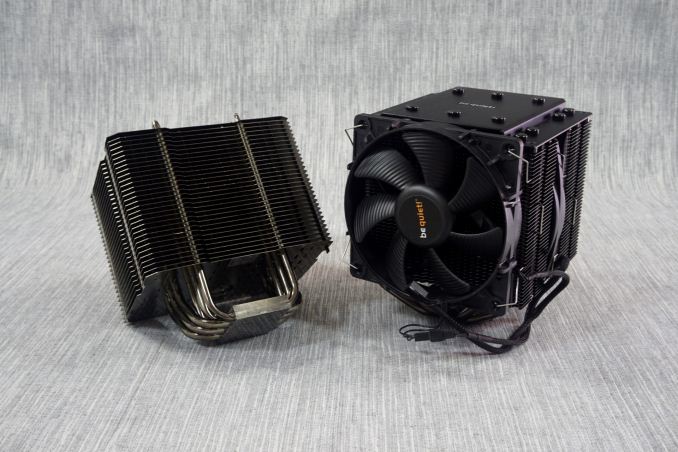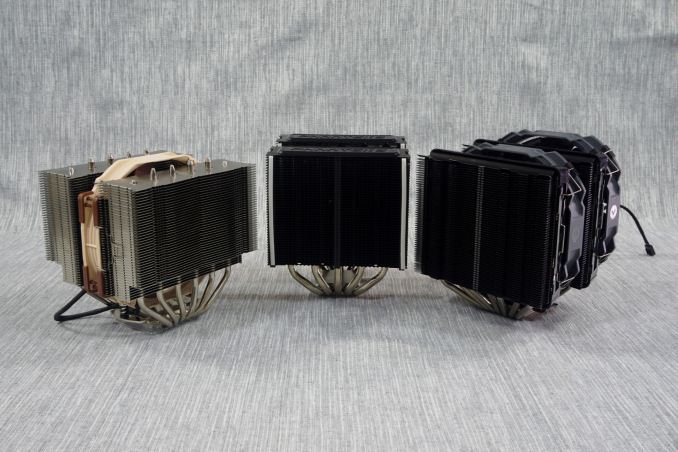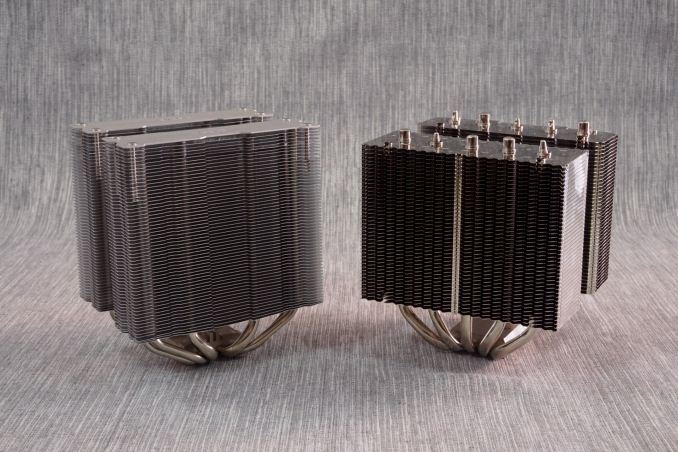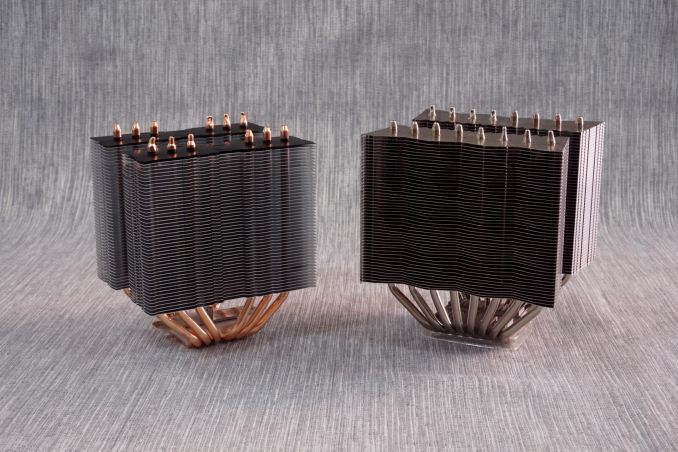Top Tier CPU Air Coolers Q3 2015: 9-Way Roundup Review
by E. Fylladitakis on July 6, 2015 8:00 AM ESTConclusion
It goes without saying that the selection of a CPU cooler is not easy. Each user has different requirements and needs. Even if we select a very specific group, such as those who are seeking the best air-based cooling solutions possible, there are different levels of tolerance to noise and different budgets. Furthermore, certain coolers could cause compatibility problems with the case or the RAM. All performance and physical aspects need to be taken into account by each individual user, weighing which option is the best for a specific application.
If thermal performance were the top priority, it would be very difficult to select between the Noctua NH-D15, the Cryorig R1 Ultimate, the Phanteks TC14PE and the Raijintek Tisis. All four of these coolers have similar thermal performance overall, with the Tisis and the NH-D15 showing a little better performance at lower loads and slightly lower noise levels. All four of these coolers are of comparable manufacturing quality as well; at least as long as the body of the cooler is concerned. A selection between these four coolers generally becomes a matter of compatibility, availability and pricing.
Noctua and Phanteks are known for their support and their willingness to offer mounting kits for new sockets, plus their design allows their front fans to be raised and increase the RAM clearance, gaining several points on compatibility. Cryorig's R1 Ultimate is visually very lustrous but its availability is extremely low. Furthermore, its plastic frame design prevents the fan to be moved up more than a few mm's, limiting RAM compatibility beneath the cooler. The Raijintek Tisis has the advantage of lower pricing but its availability is limited and its fans cannot be adjusted in terms of height at all.
When thermal performance becomes the only priority, the Reeven Okeanos overtakes the competition through sheer force. The relatively small and simple cooler hits the top of our thermal resistance charts, demonstrating the best thermal performance of this roundup review. However, this performance is solely based on its high speed fans, making the Okeanos by far the loudest cooler of this review as well. Furthermore, its availability is very low as Reeven still has very low market penetration and production. It would be easy to recommend the Okeanos to those who do not care about noise at all, but the blunt truth is that everyone does care about noise. It may not be the first priority but it definitely is a major selling factor, as nobody likes a noisy device, limiting the potential of the Okeanos.
Be Quiet!'s Dark Rock Pro 3 is clearly designed with acoustics and quality as the priorities, which generally are the focus and trademark of the company. It may be falling a little behind on thermal performance but it does deliver the promised lower noise levels. Furthermore, it is a high quality construct and comes with very high quality fans, improving its competitiveness. The acoustics performance of the Dark Rock Pro 3 is only challenged by the irregularity of our review, the Thermalright Macho Zero, a cooler designed for very low airflow environments. When paired with Thermalright's own TY-147A fan, the Macho Zero cannot offer the same thermal performance as the rest of the coolers but it is practically noiseless. Its wide fin spacing has very low airflow impedance, making the cooler optimized for semi-fanless operation. This means that the Macho Zero is designed to rely on the airflow of a case and operate without a fan at all, or to operate with a high-CFM case fan installed on it. Because of the low airflow impedance, the noise level of the Macho Zero is notably lower than that of conventional coolers, while it does offer good thermal performance. For those that acoustics are a primary concern, the Macho Zero definitely holds a major advantage.
The last two coolers of this review are the SlientiumPC Grandis XE1236 and the Deepcool Assassin. The former is by far cheaper than any other solution of this review and, considering its thermal performance, we wonder if it would be more reasonable to compare it against middle-range coolers, not the largest and mightiest behemoths out there. The only real comparison with the rest of the coolers in this review is its size and dual tower design. SilentiumPC however does not exaggerate, openly claiming that the primary design factor of their products is cost. True enough, the Grandis XE1236 is very competitively priced and offers acceptable overall performance, making it a very interesting solution for users on a tight budget. The Deepcool Gamerstorm Assassin is a more complicated matter. The design, size and, until recently, the price of this cooler were hinting that the Assassin is on par with the best coolers out there. However, despite its grandiose appearance, the Assassin generally fails to impress and it would be in great trouble if a massive price cut would not take place just a few days ago. With its retail price reduced by 25-30%, the Assassin becomes a viable solution, competing in terms of value rather than performance, making it a higher quality solution over the Grandis at an acceptable cost.
Ultimately, if our conclusions could be summarized in a single table, it would be this:
| 9-Way CPU Cooler Quick Conclusions | |||
| Priority | Cooler | Reason | |
| Best Thermal Performance |
Noctua NH-D15 $93 |
Reeven Okeanos 60€ (≈$54*) |
If raw thermal performance is the only concern, these two air-based coolers offer the best there is. Arguably, the Okeanos is far too loud but, even though the high performance solely comes from strong fans, it retails for nearly half the price of the NH-D15. Therefore, the final selection depends on secondary targets and the budget. |
| Quietest | Thermalright Macho Zero $65 (no fan) |
Be Quiet! Dark Rock Pro 3 $86.50 |
When low noise is the primary selection factor, Thermalright wins hands down. Be Quiet!'s Dark Rock Pro 3 would be our next choice, as it is a complete solution with fans and offers better thermal performance at comparatively low noise levels. |
| Best Value | SilentiumPC Grandis XE1236 £34.90 (≈$45*) |
Phanteks TC14PE $80 |
Out of the nine coolers of this review, the Grandis may not be the best performer but it is by far the cheapest. For those that are satisfied with good performance and just want a good cooler, it will not disappoint. For those in the US, Phanteks' TC14PE offers very good quality and performance at a competitive price. |
| Realistic selection (or what I, as an enthusiast/overclocker, would buy) |
Noctua NH-D15 $93 |
To my eyes, Noctua's NH-D15 is the most balanced product of this review. It offers excellent thermal performance at reasonable noise levels, the quality is exceptional, all while the retail price is not extravagant. | |














135 Comments
View All Comments
zodiacfml - Tuesday, July 7, 2015 - link
Someone should test for this. It is quite plausible as it will take time to increase the temperature of water/coolant in the system. Yet, for longer and continuous loads, surface area matters to dump heat in the environment which AIO coolers has less to a similarly priced Big Air cooler which shows in benchmarks.Navvie - Tuesday, July 7, 2015 - link
Pretty good.It'd be nice if there was a base line (say intel's current stock cooler) and an AIO water cooler to show the difference between a top tier air cooler and what many consider to be the next step.
One point, SPCR always test each cooler with a 'reference' fan, making it easier to compare the heatsink's efficiency. Can't help but feel you didn't complete the task you set out to by levelling the playing field with your simulated CPU heat source.
maximumGPU - Tuesday, July 7, 2015 - link
Great roundup! i for one still believe high end air a good alternative to water if you want dead silence.What i still can't understand is how can Nocuta get away with shipping the most expensive air cooler, likely to be used by enthusiasts who care about aesthetics, with the most hideous fan colours?
'nar - Tuesday, July 7, 2015 - link
Noctua colors are odd, but I think it forces you to consider performance more than aesthetics. They do look nice, but not "cool" - no pun in tended.Dead silence basically depends on how much heat you need to dissipate, temperature of ambient air, surface area of fins/radiator, air flow, and heat transfer capability of the cooler. Or more basically, how easily you can transfer heat from CPU to the air. Water increases the efficiency of heat transfer, so once you reach a certain power level they will overtake HSF's. They will never be as quite as a good HSF, at least not on low-power CPU's that arguably do not need anything but the stock cooler to begin with.
xthetenth - Tuesday, July 7, 2015 - link
Noctua gets away with those colors entirely because they're Noctua. Yes they're not pretty colors, but unlike nice bright/garish colors they are an unmistakable sign that they're the best or at least tied for best.piroroadkill - Wednesday, July 8, 2015 - link
Your keyboard seems to have a problem, you've typed "hideous" when clearly "fantastic" would be better. Noctua fans are neat.Beaver M. - Wednesday, July 15, 2015 - link
Well, serious people are more likely to buy Noctua anyway. And no serious user cares about what the fans look like, and even if they did, they would still take the Noctua, since you can CLEARLY see the extremely high quality they are just by looking at them. Windows in cases and other stupid bling bling is for the PC-ricer gang. They only choose after looks anyway, and dont care if their fans make noises from day one.PrinceGaz - Tuesday, July 7, 2015 - link
Excellent review of what seem to be very good HSFs throughout (but then again, you did ask them to send their best).A comparison with the stock Intel cooler as supplied with something like the 4790K would be nice, as that is what any expense on a third-party cooler must be compared against. How would the stock-cooler compare at 340W? I was very impressed with the degC/W figures for all those coolers; it almost makes 340W seem an amount of heat that can be dealt with, though I'm thinking it's crazy.
As well as the stock-cooler from a highish end CPU, one or two commonly used AIO liquid-coolers needs to be added to provided a second comparison point, as these high-end air-coolers are presumably expected to be near, possibly even better than a liquid AIO.
I love the fact you are using a properly designed heating rig, and your comprehensive review, but I came away thinking: they're good! But I've no idea how much better they are than the stock cooler, or how any of them would compare with the liquid AIOs also available, both in terms of cooling or noise.
Sivar - Tuesday, July 7, 2015 - link
This is probably the best CPU cooler article I've read (and I read such articles when Anandtech when it was on Geocities).Excellent writing, useful measurements, and a cogent conclusion. Thank you, Emmanouil!
orangesky - Tuesday, July 7, 2015 - link
SilentPcReview just posted a review of the new Scythe Ninja 4: http://www.silentpcreview.com/article1462-page1.ht... The review includes some good comparison tables with many of the popular air & water coolers.Sounds like a pretty decent option, and probably the best Ninja since the original.